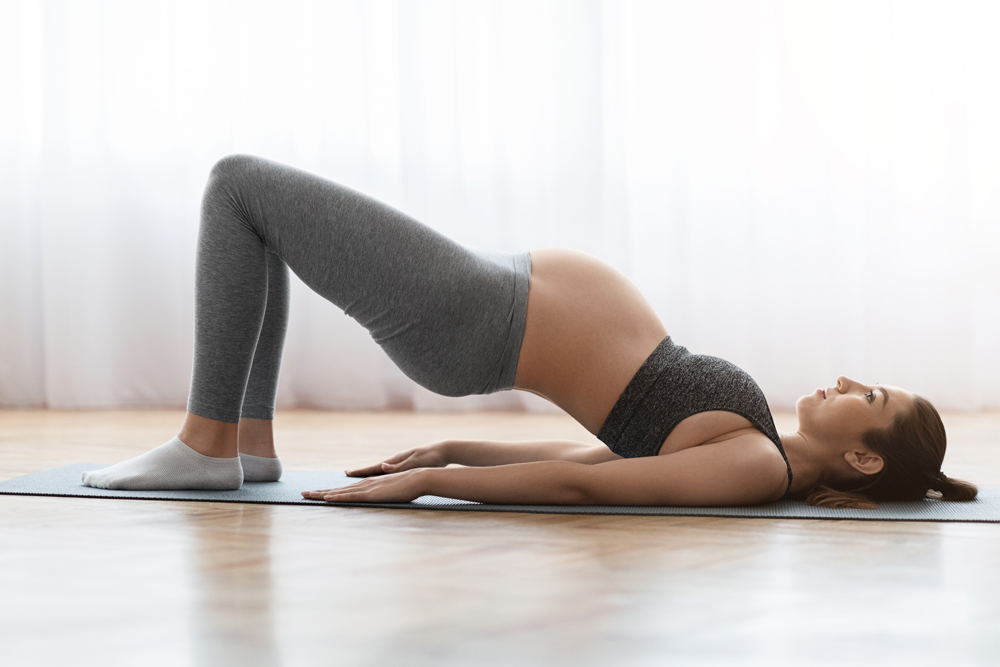Experiencing Pelvic Pain in Pregnancy? Exercises to Keep Your Hips and Pelvis Stable and Strong
This article is proudly brought to you in partnership with Move It Mama.
Pregnancy related pelvic pain is really common among pregnant people. During pregnancy, the pelvis widens and the ligaments loosen to prepare the body for birth. As a result, the stability of the pelvis and hips can be compromised (largely due to relaxin, a hormone responsible for loosening the pelvis and surrounding ligaments).
As the pelvis loses stability, other muscles tend to overcompensate and can also become tight, stiff and even painful. While this can happen in the first trimester, pelvic pain is more typically seen in the later stages of pregnancy.
There are various exercises pregnant people can do to help keep the hips and pelvis stable and strong:
1. Pelvic Tilts
Performing pelvic tilts can not only help with posture and alignment but also help to relieve pelvic or low back pain.
Choose either to lie on your back with feet on the floor and knees bent (if comfortable to do so or if you’re in the earlier stages of pregnancy), or perform on all fours (cat/cow position) with hands under shoulders and knees under hips. Inhale and, as you exhale, actively engage the core and pelvic floor while tucking the pelvis under, imagining bringing your pubic bone to your abdomen. Relax and repeat.
Note: If suffering from tightness and pain in the hips or pelvis, referring to the above cat/cow stretch can be helpful for some relief. Adding a child’s pose stretch can also be really effective to relieve tightness in the area.
ADVERTISEMENT
2. Bridging Exercises (Elevated if needed)
Glute bridges are a great exercise for keeping glutes and hamstrings strong, and will help with muscular stability to the pelvis.
All pregnant people will differ in terms of whether they are comfortable lying on their back. Our advice is to use a sturdy incline to elevate the upper back when required (e.g. couch arm, bed, bench) – this may be needed in trimester two or three.
Lie on your back with feet on the floor and knees up (or elevate your back to the incline to ensure stability). Perform the pelvic tilt, as above, and as you do so, drive the hips up to the ceiling while pushing the knees forward slightly, ensuring not to overstretch and arch the lower back at the top of the movement. As you drive the hips up, exhale, activate the core and pelvic floor, and squeeze the glutes (butt) at the top. Slowly lower the hips back to the ground while inhaling and relaxing. Rest and repeat.
3. Squats
A simple yet great exercise for strengthening quads, hamstrings, and glutes. Squats will help keep your pelvis strong and functional, and ideally capable of going about daily activities without pain.
With feet just outside hip width apart and slightly turned out, squat down by bending at the knees as though you’re sitting down on the toilet. Only squat as low as feels good. Knees should push outward in line with the toes. Drive back up through the heels and squeeze glutes at the top. Try exhaling on the way up while activating the core and pelvic floor. If you find yourself needing some support, try holding onto something like the wall or even try squatting to a bench, bed or couch.
4. Good Mornings
Good mornings are similar to the bridge movement, in that it is hip dominant, and lends focus to the pelvic tilt from exercises one and two, above.
Stand upright in a neutral posture with feet about hip width apart. Place hands at the back of your head with elbows out at the sides. Actively squeeze your upper back together. With neutral posture and a straight back, bend over at the hips until you’re folded at about 90 degrees. Keep the neck neutral and the knees slightly soft/ever so slightly bent. Try a tempo of around 2-3 counts down and a count of one on the way up. Exhale on the way up, activate the core and pelvic floor and perform a slight pelvic tilt at the top. Relax and repeat for reps.
Move it Mama’s pregnancy/postpartum sessions offer a variety of bodyweight exercises that can also be really beneficial to hip and pelvic stability throughout pregnancy and postpartum. Join the movement today.
"*" indicates required fields





